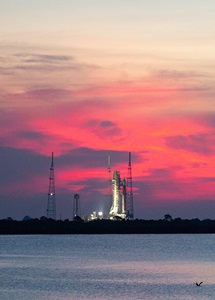Building on the legacy of the Apollo and Space Shuttle programs, Northrop Grumman is pushing the limits of possible with the Artemis program.
On a Moon Mission
Keeping the Astronauts of the Artemis II Safe

By Adam Stone
NASA's upcoming Artemis II mission promises to break new ground in making space travel safer. Building on the success of the uncrewed Artemis I mission in 2022, the next will be NASA's first with a human crew. Happening aboard the Orion spacecraft atop the Space Launch System (SLS) rocket, this will pave the way for future Artemis missions to land the first woman and person of color on the moon.
Space travel is complex and awe-inspiring. It's also something that our team at Northrop Grumman knows very well. And the most critical element of executing space travel, especially with astronauts on board, comes down to one thing: safety.
Breaking Free
In the event of an early-stage emergency, the Launch Abort System (LAS) is critical.
A three-motor system, the LAS is comprised of the abort motor, attitude control motor (ACM) and jettison motor that act together to lift the Orion spacecraft from the SLS rocket quickly and reorient it for a safe landing. It is fundamentally different from how the space shuttle was safeguarded; the entire shuttle had to be guided back to Earth in the event of engine loss or other abort scenarios with no capability to escape from a catastrophic failure. The ability to escape from the launch vehicle in the event of a potentially dangerous emergency situation, though, requires a different approach.
"After the vehicle is launched and you're flying through the first portion of the mission, you're not only overcoming gravity with that massive amount of fuel — you're also facing aerodynamic forces, with the atmosphere pushing back on the vehicle, wanting to slow it down and break it," Adam Lyons said, chief engineer for the LAS abort motor at Northrop Grumman. "We need a way to get away from the launch vehicle if something were to go wrong."
In that case, the LAS abort motor will pull the astronauts' capsule away from the SLS rocket, explained Adam. It will deliver a six-second burn of solid rocket fuel, pulling the capsule away from the unsafe environment. The LAS is then jettisoned, freeing the capsule for a parachute-supported return to Earth.
Steering to Safety
The ACM, which Northrop Grumman also manufactures, helps reorient the crew capsule for parachute deployment and a safe landing back on Earth.
"The unique feature of the ACM is the controllable thrust," said Patricia Bouknight-Hamilton, Northrop Grumman Space Programs Market Area Director. "Firing those thrusters releases gas, which gets Orion into an upright position. It is an extraordinary design that was not available on shuttle, using proportional thrust valves made possible by our patented technology."
Those valves represent a game-changer.
"I see these proportional valves as a stepping-stone for other applications where safe, controllable solid systems might be used — such as for landers throughout the solar system," Senior Director of Program Management John Arrell said.
Going to the Moon — and Beyond
As part of developing and certifying a safe design, we test to the extremes of the expected environment and each of the LAS motors have gone through strenuous development and qualification testing. This was required to acquire LAS human-rated status, which is the process of designing, evaluating and testing the system to ensure the safety of the astronauts.
"We have years of experience developing technology used in space. We know how solid rocket propellant behaves and how to make it do what we want it to do," Adam said. "That's the kind of expertise you need when you're pushing a boundary on something that didn't previously exist."
Work on the abort motor in particular promises to have a far-reaching impact. Its development required engineers to create a novel protection system for lightning strikes, a common hazard in Earth's upper atmosphere.
"We put a lot of work into developing the lightning protection system for the abort motor, and that effort has started to propagate across the industry," Adam said. "Similar systems are already starting to be used on other programs, so there's a lot of potential impact there in the future."
SLS is the only rocket launched by the world’s largest and most powerful solid rocket boosters and capable of carrying astronauts to deep space. Having a safety system in the event of an emergency will be imperative as humans look to their next cosmic step: living on and around the moon, and perhaps even beyond.
Learn more about our work supporting NASA’s Artemis mission, or explore what life’s like working at Northrop Grumman.


